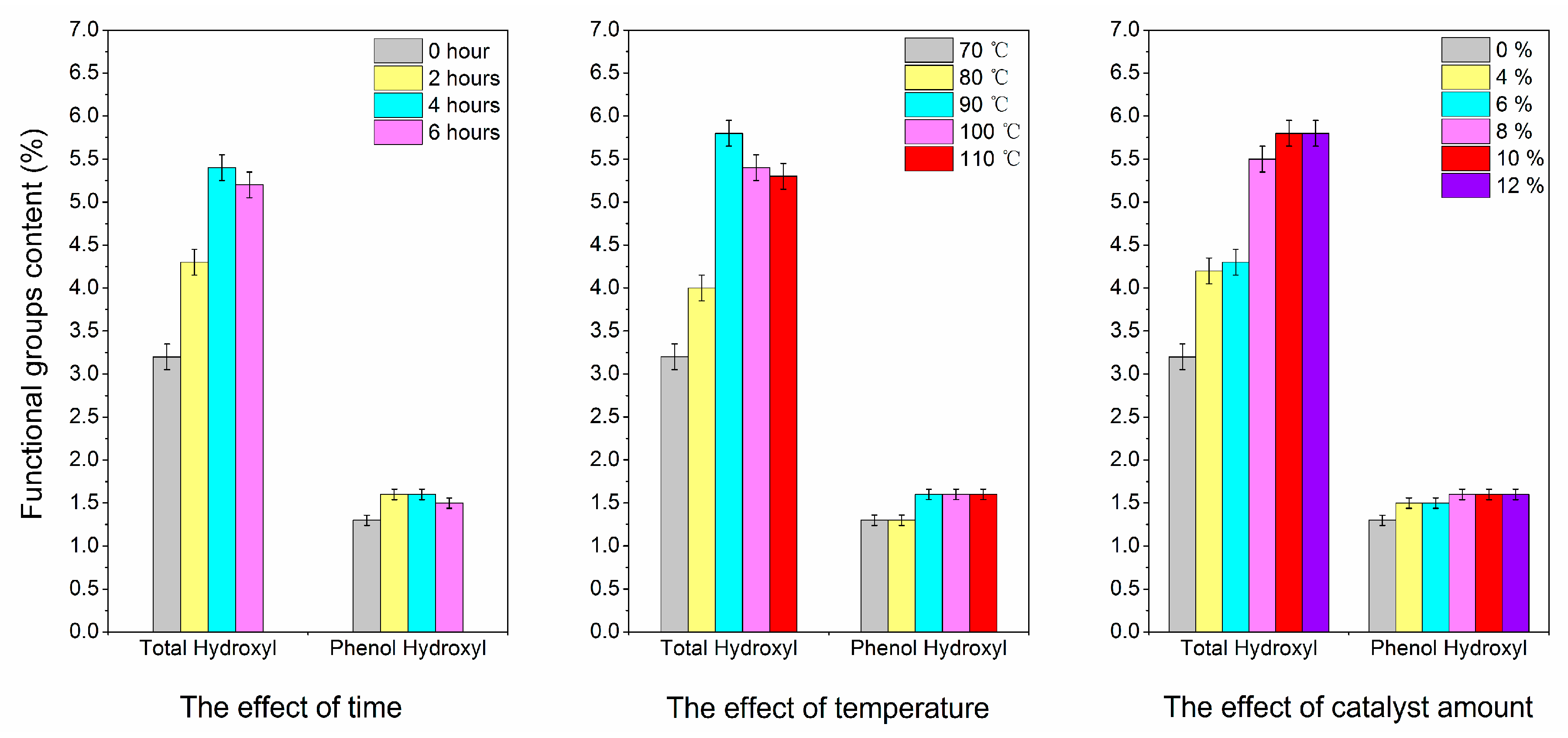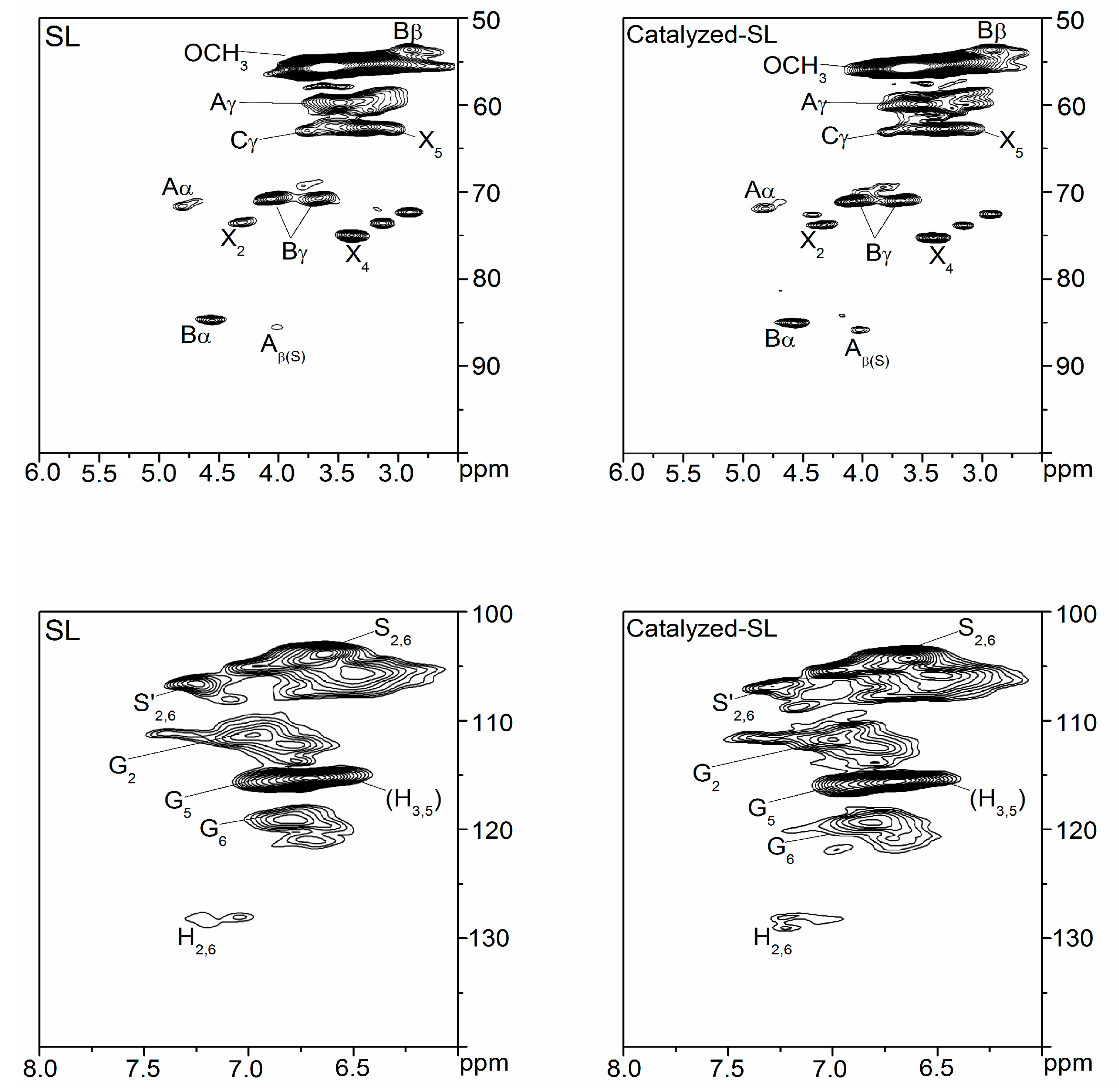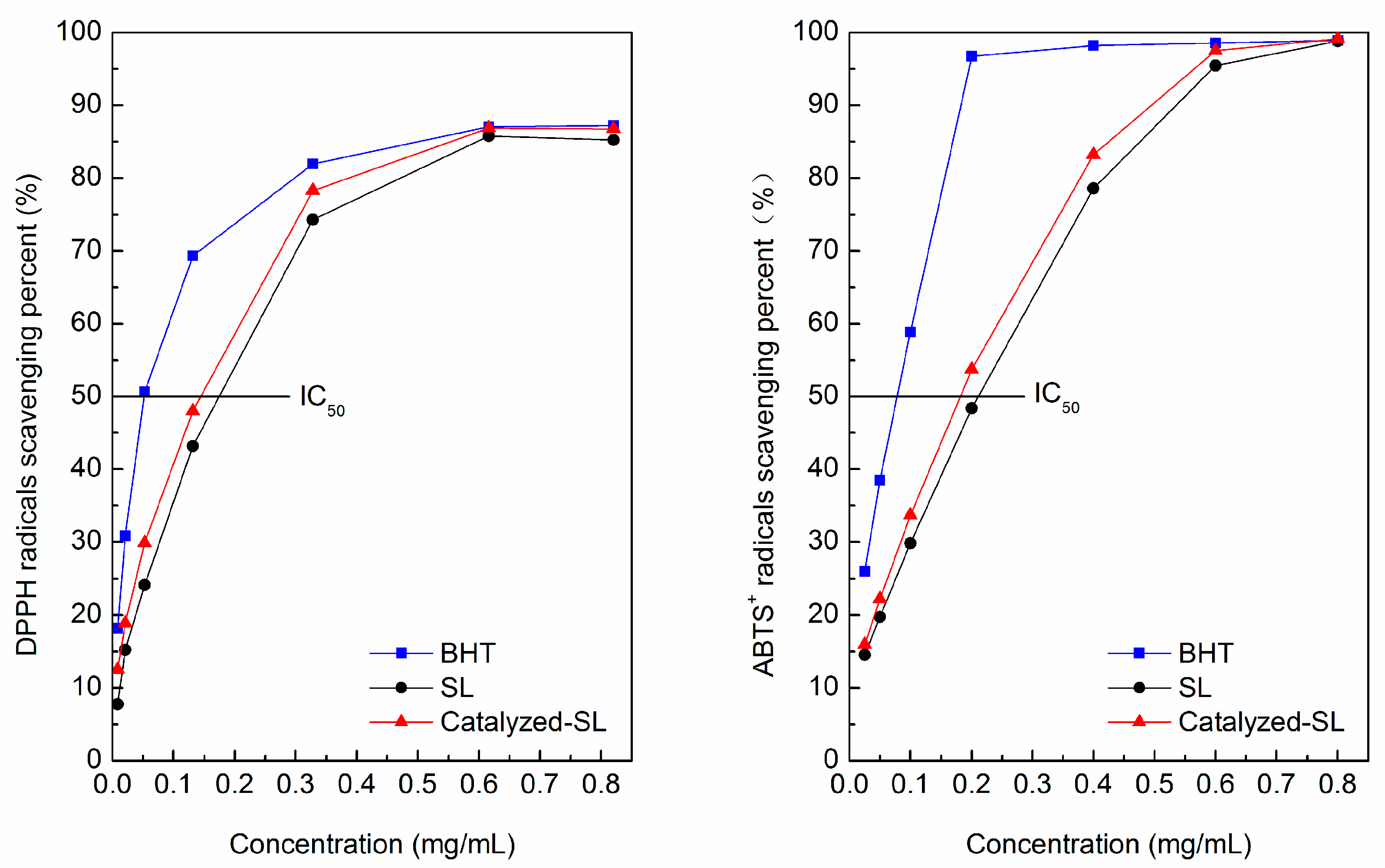Hydrogenolysis and Activation of Soda Lignin Using [BMIM]Cl as a Catalyst and Solvent
Abstract
:1. Introduction
2. Materials and Methods
2.1. Materials
2.2. Degradation of Soda Lignin
2.3. Characterization of Products
2.4. Antioxidant Activity
3. Results
3.1. Degradation and Activation of Soda Lignin
3.2. Characterization of Products
3.3. Antioxidant Activities
4. Discussion
5. Conclusions
Acknowledgments
Author Contributions
Conflicts of Interest
References
- Laurichesse, S.; Averous, L. Chemical modification of lignins: Towards biobased polymers. Prog. Polym. Sci. 2014, 39, 1266–1290. [Google Scholar] [CrossRef]
- Song, Y.; Wang, Z.X.; Yan, N.; Zhang, R.; Li, J.C. Demethylation of wheat straw alkali lignin for application in phenol formaldehyde adhesives. Polymers 2016, 8, 209. [Google Scholar] [CrossRef]
- Koumba-Yoya, G.; Stevanovic, T. Study of organosolv lignins as adhesives in wood panel production. Polymers 2017, 9, 46. [Google Scholar] [CrossRef]
- Zhang, Q.; Wang, D.; Bei, Y.; Ren, S.X.; Fang, G.Z. Flocculation performance of trimethyl quaternary ammonium salt of lignin-sodium alginate polyampholyte. BioResources 2013, 8, 3544–3555. [Google Scholar] [CrossRef]
- Su, L.; Zhang, S.M.; Jiang, G.Q.; Pang, J.Y.; Wang, D.; Shi, J.Y.; Fang, G.Z. Layer-by-layer self-assembly of a lignin–poly(vinyl alcohol) based polyelectrolyte with a conductivity method. J. Appl. Polym. Sci. 2017, 134, 44416. [Google Scholar] [CrossRef]
- Klapiszewski, L.; Pawlak, F.; Tomaszewska, J.; Jesionowski, T. Preparation and characterization of novel PVC/silica–lignin composites. Polymers 2015, 7, 1767–1788. [Google Scholar] [CrossRef]
- Azadi, P.; Inderwildi, O.R.; Farnood, R.; King, D.A. Liquid fuels, hydrogen and chemicals from lignin: A critical review. Renew. Sustain. Energy Rev. 2013, 21, 506–523. [Google Scholar] [CrossRef]
- Zhang, S.M.; Su, L.; Liu, L.; Fang, G.Z. Degradation on hydrogenolysis of soda lignin using CuO/SO42−/ZrO2 as catalyst. Ind. Crop. Prod. 2015, 77, 451–457. [Google Scholar] [CrossRef]
- Zhang, S.M.; Liu, L.; Ma, Y.L.; Fang, G.Z. Antioxidant activity of hydrogen-reduced alkali lignin prepared using SO42−/ZrO2 as catalyst. J. Funct. Mater. 2014, 45, 71–75. [Google Scholar] [CrossRef]
- Zhang, S.M.; Zhang, Y.; Liu, L.; Fang, G.Z. Antioxidant activity of organosolv lignin degraded using SO42−/ZrO2 as catalyst. BioResources 2015, 10, 6819–6829. [Google Scholar] [CrossRef]
- D’Arrigo, P.; Allegretti, C.; Tamborini, S.; Formantici, C.; Galante, Y.; Pollegioni, L.; Mele, A. Single-batch, homogeneous phase depolymerization of cellulose catalyzed by a monocomponent endocellulase in ionic liquid [BMIM][Cl]. J. Mol. Catal. B 2014, 106, 76–80. [Google Scholar] [CrossRef]
- Sun, P.; Armstrong, D.W. Ionic liquids in analytical chemistry. Anal. Chim. Acta 2010, 661, 1–16. [Google Scholar] [CrossRef] [PubMed]
- Zhao, H.B.; Holladay, J.E.; Brown, H.; Zhang, Z.C. Metal chlorides in ionic liquid solvents convert sugars to 5-hydroxymethylfurfural. Science 2007, 316, 1597–1600. [Google Scholar] [CrossRef] [PubMed]
- Xu, J.K.; Li, M.F.; Sun, R.C. Identifying the impact of ultrasound-assisted extraction on polysaccharides and natural antioxidants from Eucommia ulmoides Oliver. Process Biochem. 2015, 50, 473–481. [Google Scholar] [CrossRef]
- Binder, J.B.; Gray, M.J.; White, J.F.; Zhang, Z.C.; Holladay, J.E. Reactions of lignin model compounds in ionic liquids. Biomass Bioenergy 2009, 33, 1122–1130. [Google Scholar] [CrossRef]
- Jia, S.Y.; Cox, B.J.; Guo, X.W.; Zhang, Z.C.; Ekerdt, J.G. Cleaving the β-O-4 bonds of lignin model compounds in an acidic ionic liquid, 1-H-3-Methylimidazolium chloride: An optional strategy for the degradation of lignin. ChemSusChem 2010, 3, 1078–1084. [Google Scholar] [CrossRef] [PubMed]
- Cox, B.J.; Ekerdt, J.G. Depolymerization of oak wood lignin under mild conditions using the acidic ionic liquid 1-H-3-methylimidazolium chloride as both solvent and catalyst. Bioresour. Technol. 2012, 118, 584–588. [Google Scholar] [CrossRef] [PubMed]
- Yan, B.; Li, K.L.; Wei, L.G.; Ma, Y.C.; Shao, G.L.; Zhao, D.Y.; Wan, W.Y.; Song, L.L. Understanding lignin treatment in dialkylimidazolium-based ionic liquid-water mixtures. Bioresour. Technol. 2015, 196, 509–517. [Google Scholar] [CrossRef] [PubMed]
- Zhang, L.M.; Yuan, T.Q.; Xu, F.; Sun, R.C. Enhanced hydrophobicity and thermal stability of hemicelluloses by butyrylation in [BMIM]Cl ionic liquid. Ind. Crops Prod. 2013, 45, 52–57. [Google Scholar] [CrossRef]
- Lai, Y.Z.; Funaoka, M. The distribution of phenolic hydroxyl groups in hardwood lignins. J. Wood Chem. Technol. 1993, 13, 43–57. [Google Scholar] [CrossRef]
- Wen, J.L.; Xue, B.L.; Xu, F.; Sun, R.C. Unveiling the structural heterogeneity of bamboo lignin by in situ HSQC NMR technique. BioEnergy Res. 2012, 5, 886–903. [Google Scholar] [CrossRef]
- Faix, O. Classification of lignins from different botanical origins by FT-IR spectroscopy. Holzforschung 1991, 45, 21–27. [Google Scholar] [CrossRef]
- Baddi, G.A.; Hafidi, M.; Cegarra, J.; Alburquerque, J.A.; Gonzalvez, J.; Gilard, V.; Revel, J.C. Characterization of fulvic acids by elemental and spectroscopic (FTIR and C–13–NMR) analyses during composting of olive mill wastes plus straw. Bioresour. Technol. 2004, 93, 285–290. [Google Scholar] [CrossRef] [PubMed]
- Wen, J.L.; Sun, S.L.; Xue, B.L.; Sun, R.C. Recent advances in characterization of lignin polymer by solution-state nuclear magnetic resonance (NMR) methodology. Materials 2013, 6, 359–391. [Google Scholar] [CrossRef]
- Del Rio, J.C.; Rencoret, J.; Prinsen, P.; Martinez, A.T.; Ralph, J.; Gutierrez, A. Structural characterization of wheat straw lignin as revealed by analytical pyrolysis, 2D–NMR, and reductive cleavage methods. J. Agric. Food Chem. 2012, 60, 5922–5935. [Google Scholar] [CrossRef] [PubMed]
- Zhang, L.M.; Gellerstedt, G. Quantitative 2D HSQC NMR determination of polymer structures by selecting suitable internal standard references. Magn. Reson. Chem. 2007, 45, 37–45. [Google Scholar] [CrossRef] [PubMed]
- Mousavioun, P.; Doherty, W.O.S. Chemical and thermal properties of fractionated bagasse soda lignin. Ind. Crop. Prod. 2010, 31, 52–58. [Google Scholar] [CrossRef]
- Ge, Y.Y.; Wei, Q.; Li, Z.L. Preparation and evaluation of the free radical scavenging activities of nanoscale lignin biomaterials. BioResources 2014, 9, 6699–6706. [Google Scholar] [CrossRef]
- Aadil, K.R.; Barapatre, A.; Sahu, S.; Jha, H.; Tiwary, B.N. Free radical scavenging activity and reducing power of Acacia nilotica wood lignin. Int. J. Biol. Macromol. 2014, 67, 220–227. [Google Scholar] [CrossRef] [PubMed]
- Ugartondo, V.; Mitjans, M.; Vinardell, M.P. Comparative antioxidant and cytotoxic effects of lignins from different sources. Bioresour. Technol. 2008, 99, 6683–6687. [Google Scholar] [CrossRef] [PubMed]
- Dizhbite, T.; Telysheva, G.; Jurkjane, V.; Viesturs, U. Characterization of the radical scavenging activity of lignins-natural antioxidants. Bioresour. Technol. 2004, 95, 309–317. [Google Scholar] [CrossRef] [PubMed]
- Arshanitsa, A.; Ponomarenko, J.; Dizhbite, T.; Andersone, A.; Gosselink, R.J.A.; van der Putten, J.; Lauberts, M.; Telysheva, G. Fractionation of technical lignins as a tool for improvement of their antioxidant properties. J. Anal. Appl. Pyrol. 2013, 103, 78–85. [Google Scholar] [CrossRef]
- Thana, P.; Machmudah, S.; Goto, M.; Sasaki, M.; Pavasant, P.; Shotipruk, A. Response surface methodology to supercritical carbon dioxide extraction of astaxanthin from Haematococcus pluvialis. Bioresour. Technol. 2008, 99, 3110–3115. [Google Scholar] [CrossRef] [PubMed]
- Miles-Barrett, D.M.; Neal, A.R.; Hand, C.; Montgomery, J.R.D.; Panovic, I.; Ojo, O.S.; Lancefield, C.S.; Cordes, D.B.; Slawin, A.M.Z.; Lebl, T.; et al. The synthesis and analysis of lignin-bound Hibbert ketone structures in technical lignins. Org. Biomol. Chem. 2016, 14, 10023–10030. [Google Scholar] [CrossRef] [PubMed]
- Mitchell, V.D.; Taylor, C.M.; Bauer, S. Comprehensive analysis of monomeric phenolics in dilute acid plant hydrolysates. BioEnergy Res. 2014, 7, 654–669. [Google Scholar] [CrossRef]
- Deuss, P.J.; Scott, M.; Tran, F.; Westwood, N.J.; de Vries, J.G.; Barta, K. Aromatic monomers by in situ conversion of reactive intermediates in the acid-catalyzed depolymerization of lignin. J. Am. Chem. Soc. 2015, 137, 7456–7467. [Google Scholar] [CrossRef] [PubMed]
- Chiappe, C.; Leandri, E.; Tebano, M. [Hmim][NO3]—An efficient solvent and promoter in the oxidative aromatic chlorination. Green Chem. 2006, 8, 742–745. [Google Scholar] [CrossRef]






| Sample | Mw | Mn | Mw/Mn |
|---|---|---|---|
| SL | 8220 | 3120 | 2.63 |
| Catalyzed-SL | 6450 | 2150 | 3.00 |
© 2017 by the authors. Licensee MDPI, Basel, Switzerland. This article is an open access article distributed under the terms and conditions of the Creative Commons Attribution (CC BY) license (http://creativecommons.org/licenses/by/4.0/).
Share and Cite
Zhang, S.; Liu, L.; Fang, G.; Yan, N.; Ren, S.; Ma, Y. Hydrogenolysis and Activation of Soda Lignin Using [BMIM]Cl as a Catalyst and Solvent. Polymers 2017, 9, 279. https://doi.org/10.3390/polym9070279
Zhang S, Liu L, Fang G, Yan N, Ren S, Ma Y. Hydrogenolysis and Activation of Soda Lignin Using [BMIM]Cl as a Catalyst and Solvent. Polymers. 2017; 9(7):279. https://doi.org/10.3390/polym9070279
Chicago/Turabian StyleZhang, Shengming, Liang Liu, Guizhen Fang, Ning Yan, Shixue Ren, and Yanli Ma. 2017. "Hydrogenolysis and Activation of Soda Lignin Using [BMIM]Cl as a Catalyst and Solvent" Polymers 9, no. 7: 279. https://doi.org/10.3390/polym9070279






